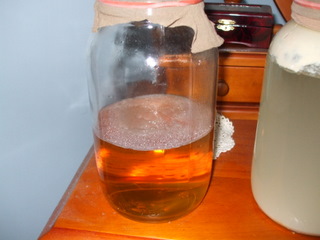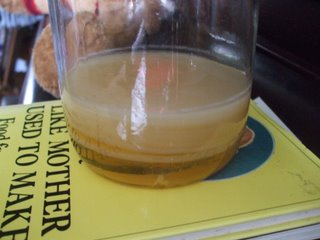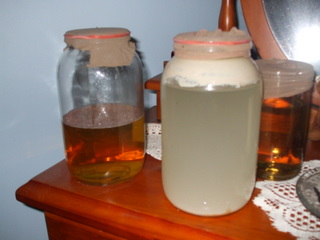I have made vinegar! Unfortunately, wish as I might, that is not true, it is the collection of bacteria and cellulose that is “mother of vinegar” (mycoderma aceti) that has made it for me. How can you get hold of this mother of vinegar I hear you ask? Well to my mind there seems to be three ways –
- Buy some – A less than satisfying solution because this is about doing things for yourself, but perhaps the quickest and easiest option if it is available to you. Here in Aus the suppliers seem to pretty few and far between. At least I was not able to locate one.
- Buy some unpasteurised vinegar – better, but not perfect. I did go down this route and it worked well for me, more of that later. Residual mother of vinegar will in commercial vinegars cause them to go cloudy so they are mostly pasteurised and/or preserved chemically to prevent it re-forming. Thankfully there are still some health food shops and even producers who will sell at least cider vinegar in its unadulterated/untreated form.
- Start from scratch – Not very technical and it does take some time, but by fermenting your own alcoholic beverage and then leaving it uncovered and untreated, with access to the air those wonderful bacteria will find YOU! Although even this approach is not without its problems.
So how difficult was it? Mmmm, reasonably!
My idea of having four compartments in my vinegar factory is that they would each contain a different type of vinegar: one for cider, one for white wine, one for red wine, and one for.... cleaning vinegar. You know the stuff they talk about in the natural cleaning books that show you how to clean your house with 3 or 4 natural products. Well one of them is invariably white vinegar, so how cool would it be to make your own?
Anyway, that was the theory and I suppose we should discuss how each one went down –
Cider Vinegar – This one was perhaps the easiest. Get hold of some of that “live” cider vinegar from your local health food shop or wherever. It doesn’t matter whether it is organic, biodynamic or what, it just has to be unpasteurised and unpreserved so if you see any numbers in the small print ingredients, in all probability it is preserved and won’t work. I trawled extensively through our usual supermarkets and didn’t find one that would work. The key is that they will usually tell you on the bottle that it still contains some mother-of-vinegar and not to worry if it goes a bit cloudy, that will be a selling point.
Anyway, once you have your cider vinegar grab your glass vinegar making jar and then add the contents of your vinegar bottle to it. Now top it up with an equal volume of HARD cider, remember that the reaction is between the mother-of-vinegar and alcohol so non alcoholic apple cider won’t work. It seems to work better if you de-gas your cider before adding it to the vinegar. Mix well and apply some old pantyhose or stocking material over the mouth of the jar held in place by a rubber band to act as a last defence against the bugs you don’t want.
Place the jar of vinegar/cider into your factory, shut the lid and leave it undisturbed. Over the next few weeks a thin translucent white layer should form on top of the liquid like a raft but if it is solid white, gray and/or fuzzy it may be mould and you will need to start again. You need to leave the factory as undisturbed as possible because the raft on top of the liquid can sink if the jar is knocked, say by your significant other doing the vacuuming or if one of the kids decides to “investigate”. If this happens the production of vinegar from alcohol will stop because the raft is no longer in contact with the oxygen in the air, but given time another mother-of-vinegar raft will form so not all is lost.
The end of the process is a bit difficult to gauge but the best advice I can give you is to sniff your cider regularly and when it smells vinegary enough, you’re there. Of course this is not the end of the process and I assume you will want to keep it going so pour out your vinegar into a holding container of some description, glass or stainless steel would be best and discard the mother-of-vinegar, preferably in the compost. Clean out your vinegar factory jar and give it a wash in really hot water and allow it to cool, then replace half of your vinegar batch in the factory jar and top up half and half with new hard cider, replace your pantyhose over the mouth of the jar (not on your legs) and put the jar back in your factory box to start again. Put the harvested vinegar into a nice bottle with a lid that seals and label it. If going cloudy doesn’t bother you leave it as it is otherwise you might want to try pasteurising your vinegar by heating it to a temperature of 66°C and holding for 30 minutes to keeping clear and bright.
White Wine Vinegar – While not being drinkers, we do seem to have accumulated an alarming number of alcoholic beverages (no you can’t have any, get your own!) as prizes, gifts etc and I swapped a couple of likely bottles of good plonk to my daughter for a cask of moderately priced white wine. It was, as with all wine except the stuff you make yourself, preserved with a sulphur based reducing agent designed to prevent oxidation, so I half filled the factory jar with the wine, then threw in some commercial white wine vinegar (also preserved) and left it open to the air. The theory was that the oxygen in the air would eventually react with the preservative and remove it from circulation. Nothing was happening after a month or so, I “seeded” the wine/vinegar mix with 5mls or so of the cider vinegar which by that time was starting to develop a very nice mother –of-vinegar raft on it.
The weather was still cold, we were just coming out of winter, so it took a while for anything to happen, but happen it did! Over time a very thick mother-of-vinegar formed, not the 2-3mm thick one on the cider vinegar, this was 30mm thick! Although it did seem to be doing its job and there was a definite strengthening of the vinegar odour. After the initial round of vinegar making I poured off the vinegar, removed the mother-of-vinegar, poured the vinegar back into the jar and added an equal quantity of white wine. Again it has produced a mother-of-vinegar 30mm thick so I don’t know what is going on there.
Red Wine Vinegar – Not a happy making story this one. I poured some red wine into the factory jar and left it open to the air, and again nothing happened so I inoculated it with 5mls of the cider vinegar and it seemed to form a very thin mother-of-vinegar raft. So I removed the raft and topped up with an equal amount of new red wine and so far........it has done nothing! The mother has not seemed to have its usual effect and more research is needed.
Cleaning Vinegar – Another terrific idea! Well sort of. To create the alcohol is easy, just dissolve some sugar in water, throw in some yeast and away you go. That’s what I did in the last factory jar, the idea being that the fermentation would proceed and there being no preservatives involved, the bugs would find the alcoholic solution and proceed to do their thing. Well it kind of worked but I got the wrong sort of bugs. When the yeast goes in the material carrying the yeast makes the solution cloudy, I suspect it is a flour type material, and I think it was this that resulted in furry grey layer of mould that formed instead of the mother-of-vinegar. More work is required here and I think the trick is to make the alcohol in a fermenter as you would normally; filter out any extraneous crap, then put the filtered solution into the vinegar factory. 
So if you set it up right you can have your own vinegar factory, albeit on a small scale, and produce all sorts of vinegar for yourself. I used to know one lady who would make mulberry vinegar so almost anything is possible and if at some stage you want to go into it big time – find yourself a wine barrel!



